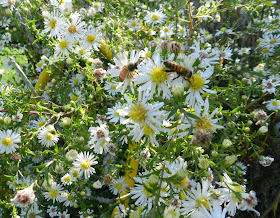A few blooms remain on the Aster pilosus, commonly known as Hairy Aster or Frost Aster. I prefer the latter name, especially since this aster is the very last to bloom and is undeterred by frost. This is a plant that appears of its own free will all over the farm; in fact, most people would probably consider it a weed rather than a wildflower. But it certainly has its redeeming qualities.
My husband has been laid up for most of the summer with back and knee problems and hasn't been able to keep up with the trimming around the farm buildings, but I'm glad he didn't get a chance to cut these Frost
Asters down in front of the old shed. I wish I had taken this photo a few weeks earlier when they first bloomed, but you'll have to take my word for it that in their prime they provided billows of white blooms that looked as good as anything I might have purposely planted here.
But the most important characteristic of the Frost Aster is that the bees love it! Blooming at the end of the season, it provides a last valuable source of food for bees before winter sets in. This plant is not for everyone, but if you would like to learn more about it, you can check out my earlier post here.
Another plant that seems to have appeared on its own is this small tree behind the butterfly garden. It took me a long time to identify it, but after seeing numerous specimens growing in the wild at our local forest preserve and then doing a little research, I finally found that it is a Rough-leaved Dogwood, Cornus drummondii. Like other tamer dogwoods, it is covered in white blooms in the spring, but I also like its burgundy foliage in the fall.
Although it is no longer blooming, I did want to include this plant from earlier this fall that also appears voluntarily all around the outbuildings. It's a type of Persicaria, probably Persicaria cespitosa though I'm not positive. I remember the first time I saw Persicaria mentioned on someone's blog and being aghast! Back in the days when farmers "walked beans"--pulling out weeds by hand in soybean fields--rather than spraying them with herbicides, I learned very quickly to identify this plant better known to us as smartweed.
As a teenager living on a farm, walking beans provided one of the few sources of a little spending money for me, and, of course, my dad believed in teaching us about the value of hard work. After hours of pulling or cutting out these plants that quickly spread to make a tangled mess, choking out the valuable soybean plants, I soon learned to hate smartweed.
Lest I offend anyone, I have since seen some lovely examples of Persicaria cultivars growing in private gardens and in botanic gardens--and I agree they are worth planting in a garden. But this is one type of Persicaria you definitely don't want in your garden, or it will quickly take over. I was pleased with this photo and thought it looked rather pretty and innocent here . . . but it met an untimely end soon after the photo shoot:)
While I was trying to find the proper botanical name for the smartweed, I was surprised to see one of my favorite plants listed in the Illinois Wildflowers website as a "weedy wildflower." Belamcanda chinensis or Blackberry Lily certainly doesn't belong in the same category as smartweed! A native of East Asia, this plant can occasionally be found growing in the wild throughout the state. However, I've tried for years to get these lilies established here with no luck--until this year. Thanks to some seeds from Frances, I was thrilled to have not one, but two blooming lilies this year.
As much as I like its unique blooms, it is in the fall that I most enjoy Blackberry Lily. One look at these berries, actually seeds, and you can see how it gets its name. Since the plant spread by either rhizomes or seeds, I might be lucky enough to have several more of those pretty little lilies in the future. While the other plants listed here probably aren't appropriate for most gardens, Blackberry Lily is a great addition anywhere for both summer and fall interest.
To learn more about other wildflowers and natives, visit our hostess Gail and her the bee-utiful garden at Clay and Limestone.
































